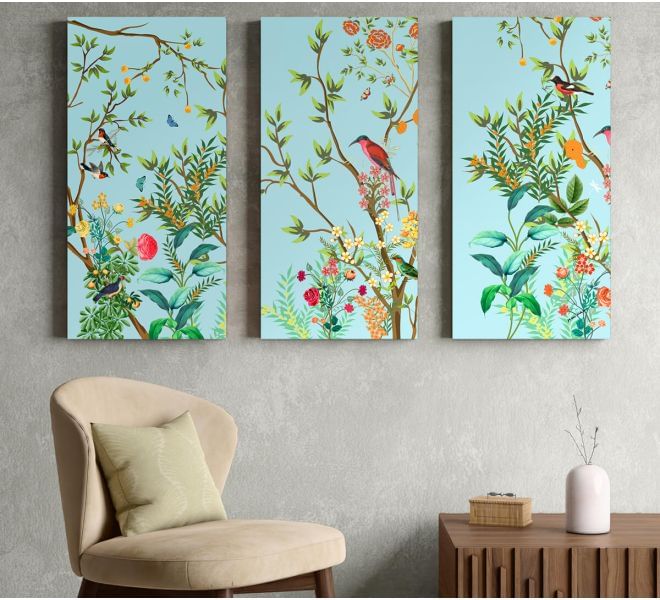The Art of Landscape Painting
Landscape painting is a timeless art form that captures the beauty and essence of nature on canvas. Artists have been depicting landscapes for centuries, using their creativity and skill to convey the awe-inspiring scenes of the natural world.
One of the key elements of landscape painting is the portrayal of light and shadow. Artists carefully observe how light interacts with the landscape, creating depth, texture, and mood in their paintings. The play of light on water, the dappled sunlight through trees, or the dramatic shadows cast by mountains all contribute to the visual impact of a landscape painting.
Color is another vital component in landscape painting. Artists use a palette of hues to evoke different seasons, times of day, and moods in their work. From vibrant sunsets to serene winter scenes, colors play a crucial role in capturing the atmosphere and emotion of a landscape.
Composition is also essential in landscape painting. Artists carefully arrange elements within the frame to create a sense of balance, harmony, and perspective. The placement of trees, mountains, rivers, and other features guides the viewer’s eye through the painting and creates a sense of depth and space.
Techniques vary among landscape painters, from realistic depictions to more abstract interpretations. Some artists focus on intricate details and precise brushwork, while others prefer looser strokes and expressive gestures to convey the essence of a scene.
Whether painted en plein air or in the studio, landscape painting allows artists to connect with nature on a profound level. It offers viewers a window into tranquil meadows, majestic mountains, serene lakes, and picturesque countryside—all from the comfort of an art gallery or home.
Through landscape painting, artists not only capture the external beauty of nature but also express their inner emotions and reflections on life. It is a medium that transcends time and space, inviting us to pause, contemplate, and appreciate the wonders of our natural world.
Eight Benefits of Landscape Painting: Celebrating Nature, Tranquility, and Artistic Expression
- Captures the beauty of nature in a visual form.
- Evokes a sense of peace and tranquility for viewers.
- Allows artists to express their connection with the natural world.
- Showcases different seasons, times of day, and weather conditions.
- Enhances the aesthetic appeal of interior spaces or galleries.
- Encourages mindfulness and contemplation through art appreciation.
- Preserves landscapes that may change or disappear over time.
- Provides a creative outlet for artists to explore light, color, and composition.
Challenges of Landscape Painting: Mastering Techniques and Overcoming Environmental Hurdles
- Requires patience and time to master the techniques involved.
- Dependent on weather conditions for outdoor painting, which can be unpredictable.
- Transporting bulky painting equipment for plein air painting can be cumbersome.
- Limited control over changing natural elements like light and weather while painting outdoors.
- May require extensive knowledge of perspective, color theory, and composition to create compelling landscapes.
Captures the beauty of nature in a visual form.
Landscape painting excels in capturing the exquisite beauty of nature in a tangible and visually captivating form. Through the skilled use of colors, light, and composition, artists are able to translate the awe-inspiring scenes of the natural world onto canvas, allowing viewers to immerse themselves in the splendor of serene meadows, towering mountains, tranquil lakes, and lush forests. This unique ability to encapsulate the essence and grandeur of nature in a visual medium not only evokes a sense of wonder and appreciation for the environment but also serves as a timeless reminder of the inherent beauty that surrounds us.
Evokes a sense of peace and tranquility for viewers.
Landscape painting has a remarkable ability to evoke a profound sense of peace and tranquility for viewers. Through the serene depiction of natural scenes such as tranquil lakes, lush forests, or rolling hills, landscape paintings offer a moment of respite from the hustle and bustle of everyday life. The harmonious colors, gentle brushstrokes, and serene compositions transport viewers to a place of calm and serenity, allowing them to escape momentarily and find solace in the beauty of nature captured on canvas.
Allows artists to express their connection with the natural world.
Landscape painting provides artists with a unique opportunity to express their deep connection with the natural world. Through their brushstrokes and color choices, artists can convey their reverence for the beauty of nature, capturing its essence and spirit on canvas. The act of immersing oneself in the landscape, whether physically or mentally, allows artists to channel their emotions, memories, and experiences into their artwork, creating a visual dialogue between the artist and the natural world. This intimate connection not only enriches the artistic process but also enables viewers to appreciate and connect with nature in a profound and meaningful way through the artist’s interpretation.
Showcases different seasons, times of day, and weather conditions.
Landscape painting offers a unique advantage in its ability to showcase the diverse beauty of nature across different seasons, times of day, and weather conditions. Artists can capture the vibrant colors of a blooming spring, the warmth of a summer sunset, the rich hues of autumn foliage, and the serene snowscapes of winter. By depicting various times of day, from the soft light of dawn to the dramatic shadows of dusk, landscape paintings evoke different moods and atmospheres. Furthermore, artists can portray a range of weather conditions such as misty mornings, stormy skies, or gentle rain showers, adding depth and realism to their compositions. Through these artistic representations, landscape painting allows viewers to experience the ever-changing and dynamic aspects of nature in a single frame.
Enhances the aesthetic appeal of interior spaces or galleries.
Landscape painting enhances the aesthetic appeal of interior spaces or galleries by bringing the beauty of the natural world indoors. The serene and captivating scenes depicted in landscape artworks add a sense of tranquility, sophistication, and visual interest to any environment. Whether hung in a living room, office, or gallery, landscape paintings create a connection to nature and evoke a sense of calm and inspiration for those who view them. The colors, textures, and composition of these artworks can transform a space, creating a harmonious atmosphere that resonates with viewers on an emotional and aesthetic level.
Encourages mindfulness and contemplation through art appreciation.
Landscape painting encourages mindfulness and contemplation through art appreciation by inviting viewers to immerse themselves in the serene beauty of nature depicted on canvas. The peaceful scenes and harmonious compositions in landscape paintings provide a moment of respite from the hustle and bustle of everyday life, allowing individuals to pause, reflect, and appreciate the wonders of the natural world. Through careful observation of details like light, color, and composition, viewers are encouraged to engage their senses fully and cultivate a sense of presence and awareness in the present moment. This meditative experience fosters a deeper connection with nature and promotes inner peace and tranquility through the power of art.
Preserves landscapes that may change or disappear over time.
Landscape painting serves as a powerful tool for preserving landscapes that are subject to change or disappearance over time. By capturing the beauty and essence of these landscapes on canvas, artists immortalize them in art, ensuring that their unique features and characteristics are preserved for future generations to appreciate. As urbanization, climate change, and other factors continue to alter the natural world, landscape paintings stand as timeless representations of these landscapes, allowing viewers to connect with and cherish them long after they may have transformed or vanished in reality.
Provides a creative outlet for artists to explore light, color, and composition.
Landscape painting offers artists a valuable creative outlet to delve into the interplay of light, color, and composition. Through the depiction of natural scenery, artists can experiment with capturing the nuances of light as it dances across the landscape, explore a diverse range of colors to evoke different moods and atmospheres, and carefully arrange elements within the frame to create visually appealing compositions. This process not only allows artists to hone their technical skills but also provides them with a platform for self-expression and artistic exploration.
Requires patience and time to master the techniques involved.
Mastering the techniques involved in landscape painting is a challenging endeavor that demands a significant amount of patience and time. Artists must dedicate themselves to honing their skills, understanding the interplay of light and color, and perfecting their brushwork to capture the essence of nature effectively. It requires countless hours of practice, experimentation, and perseverance to develop the proficiency needed to create compelling and evocative landscape paintings. Patience is not just a virtue but a necessity in navigating the complexities of this art form, as artists strive to convey the beauty and emotion of natural landscapes with precision and artistry.
Dependent on weather conditions for outdoor painting, which can be unpredictable.
Outdoor landscape painting is often hindered by its dependence on weather conditions, which can be highly unpredictable. Artists who choose to paint en plein air must contend with changing light, sudden rain showers, gusty winds, or extreme temperatures that can disrupt their creative process. The need to adapt to varying weather conditions adds an element of challenge and spontaneity to outdoor painting but also requires artists to be flexible and patient in capturing the fleeting moments of nature’s beauty.
Transporting bulky painting equipment for plein air painting can be cumbersome.
Transporting bulky painting equipment for plein air painting can be a challenging aspect of landscape painting. The need to carry easels, canvases, paints, brushes, and other supplies to remote outdoor locations can be cumbersome and physically demanding for artists. This logistical hurdle may deter some artists from engaging in plein air painting, limiting their creative exploration of natural landscapes. Despite the inconvenience, many artists find ways to overcome this con by simplifying their equipment or investing in portable and lightweight tools to make the process more manageable.
Limited control over changing natural elements like light and weather while painting outdoors.
One significant challenge of landscape painting is the limited control over changing natural elements such as light and weather when painting outdoors. Artists who choose to work en plein air must contend with the unpredictable nature of sunlight, shadows, clouds, and atmospheric conditions. The shifting light patterns and sudden weather changes can alter the mood and appearance of the landscape, requiring painters to adapt quickly and make spontaneous decisions. This lack of control adds a level of spontaneity and authenticity to outdoor painting but also presents a unique set of challenges in capturing a fleeting moment in time amidst nature’s ever-changing canvas.
May require extensive knowledge of perspective, color theory, and composition to create compelling landscapes.
Creating compelling landscapes through painting may present a challenge as it often demands a deep understanding of perspective, color theory, and composition. Artists must master the intricate principles of perspective to accurately depict spatial relationships and depth in their landscapes. Moreover, a nuanced comprehension of color theory is essential to evoke the desired mood and atmosphere in the painting. Additionally, skillful composition is crucial for arranging elements within the landscape to create a harmonious and visually engaging piece of art. The need for proficiency in these areas highlights the complexity and skill required to produce captivating landscape paintings.



